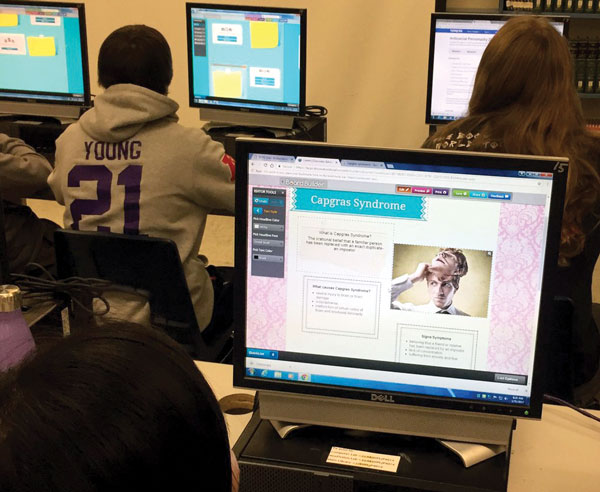Partnership Prepares Teens for College
Over the past few years, Leah Meredith, the health teacher at Perry Hall High School in Baltimore, began to notice something surprising about her students.
“Students know a lot about technology on their phones, but they don’t know the basics, such as how to put a PowerPoint together, how to cite sources, and how to summarize larg e amounts of information into small text boxes or slides,” she says. “I decided that the more skills they could learn from us, the better prepared they would be to create projects in college.”
e amounts of information into small text boxes or slides,” she says. “I decided that the more skills they could learn from us, the better prepared they would be to create projects in college.”
To achieve that goal, Meredith teamed up with Perry Hall’s library media specialist, Colleen Adams, to teach a couple of units of her health class—one on mental health, the other on drug abuse and addiction.
“Before we began working together, Mrs. Meredith’s students were doing research using print resources, links to websites she’d provided to them in handouts, and their own searches on the computer,” says Adams.
Now, students met in the library to learn research skills and how to create presentations that were more technologically savvy than handmade brochures and posters.
 While both educators wanted the students to become informed about the topics—from specific mental health conditions and addictive substances to prevention—they also wanted the teens to learn how to evaluate sources and use only the most reliable ones.
While both educators wanted the students to become informed about the topics—from specific mental health conditions and addictive substances to prevention—they also wanted the teens to learn how to evaluate sources and use only the most reliable ones.
“The sensitive nature ofthe topics of mental illness and substance abuse made it necessary to ensure that thestudents were using credible sources,” Adams says.
Meredith and Adams co-taught the class, which included discussions on research methods as well as the educators’ expectations for learning. After that, the students worked individually or in pairs to research subtopics and prepare their presentations. “We then moved into the role of facilitators: monitoring student progress, formatively assessing, and redirecting or assisting as needed,” says Adams.
They pointed students to a range of resources, including databases and such ebooks as Drug Dangers and Understanding Mental Disorders. They included links to the websites of the Mayo Clinic, National Institutes of Health (NIH), and the Centers for Disease Control and Prevention, among others.
Game-changing technology
To keep all the resources in place, they used a new cloud-based tool called Collections by Destiny, which was launched by Follett in the summer of 2017, as a way for educators to collaborate and share educational resources, whether bought or free. That high-tech bulletin board proved to be a game-changer.
“The Collections tool allowed us to put every research resource in one place so the students could easily access them from school and at home,” Adams says. “In the past, students would have to follow different paths to reach each different kind of source, whether it was a site or a database. But having every type of resource in one place cut down on the amount of time we spent instructing them how to access resources, so they could dig right into the material.”
Another plus: The teenagers had access to the materials beyond the library’s walls, which was especially helpful if a student had been absent during the lesson or needed more time to work on their project.
The Collections also helped them recognize reliable sources.
“They see the same sources over and over in each collection, so they become familiar with them,” says Meredith. “For example, my students have used NIH sources so much, they could tell you what it stands for, where they are located, and all the different subdivisions. This will benefit them when they’re doing research in college. When they see the Mayo Clinic, it will register with them: ‘Aha! I’ve used this source before.’”
At the end of each unit, the students made infographics, multimedia bulletin boards using Discovery Education Board Builder, and multimedia PowerPoint presentations.
“The students showed pride in their work and took responsibility for teaching their classmates the information they’d gained about the [type of] mental illness or drug abuse they’d chosen to research,” says Adams.
The educators will make one change, however. Next time, Adams and Meredith plan to let the students become part of the curation process by evaluating sources and adding the credible ones to the Collection boards. In that way, the students will contribute to Perry Hall school library’s atmosphere of choice, collaboration, and empowerment.
RELATED
The job outlook in 2030: Librarians will be in demand
The job outlook in 2030: Librarians will be in demand
ALREADY A SUBSCRIBER? LOG IN
We are currently offering this content for free. Sign up now to activate your personal profile, where you can save articles for future viewing






Add Comment :-
Be the first reader to comment.
Comment Policy:
Comment should not be empty !!!